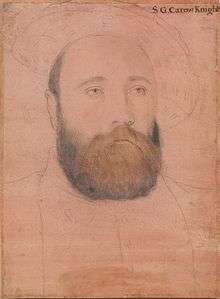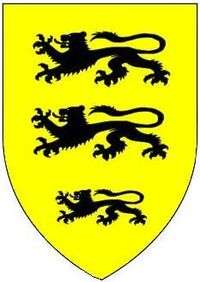George Carew (admiral)
| Admiral Sir George Carew | |
|---|---|
 by Hans Holbein the Younger, Royal Collection, Windsor Castle | |
| Born |
c. 1504 Preston |
| Died |
19 July 1545, aged c. 41 Portsmouth harbour, Battle of the Solent |
| Allegiance |
|
| Service/branch | Army, Navy |

Sir George Carew (c. 1504 – 19 July 1545) was an English soldier, admiral and adventurer during the reign of King Henry VIII who died in the sinking of the Royal Navy flagship Mary Rose at the Battle of the Solent during an attempted French invasion in the Italian War of 1542–1546. Scion of a controversial and dramatic family, Carew had a wild youth and explored widely, being arrested several times of associating with rebellious vassals of the king. Carew successfully tamed this nature in his later years, during which he became a trusted advisor and military officer in the King's service.
Origins
He was the son and heir of Sir William Carew (d.1538) of Mohuns Ottery near Luppitt in Devon by his wife Joane Courtenay, second daughter of Sir William I Courtenay (d.1485) of Powderham, Sheriff of Devon in 1488.[1] The exact date of George Carew's birth is unknown, but it is thought to have occurred between 1497 and 1504.
Childhood
George and his brother Peter Carew were sent to be educated in the household of their mother's cousin Henry Courtenay, 1st Marquess of Exeter. There they learned from adventurous relatives like their uncle Gawen Carew and kinsman Nicholas Carew, the latter of whom was later arrested and executed for treason.
Youth
Carew trained in the law, but swiftly became bored and in 1526 was in Blois, France, seeking service with Louise of Savoy, the French Regent. This attempt to serve a foreign power came to nothing, and was pardoned by King Henry VIII in November of the same year. The King also overlooked his youthful indiscretions with the followers of Elizabeth Barton and encouraged responsible behaviour in the young man.
Career
Carew became interested in politics in the early 1530s and briefly sat in 1529 as a Member of Parliament for Devon[2] and later served as High Sheriff of Devon (for 1536 and 1542), during which period he was knighted. Carew was also married for the first time during the 1530s, to Thomasine Pollard, daughter of Sir Lewis Pollard (c.1465-1540), Justice of the Common Pleas.[3]
In 1537, Carew was given his first sea commission, serving in the English Channel under Sir John Dudley during operations against pirates. In the following year 1538 he inherited his father's estates and returned to Devon to serve as Justice of the Peace. In 1539 Carew's wife Thomasine Pollard died and he again entered the King's service, taking over the strategically vital fort of Rysbank in the Calais Pale. The fort's previous commander and Carew's kinsman Nicholas Carew had paid with his life for his machinations against the King. George Carew was disgusted with the poor state of readiness and repair in which he found the fort and set about effecting repairs and became involved in the administration of Calais under its Deputy Arthur Plantagenet, 1st Viscount Lisle.[3]
Government service
Carew took pains during this period to distance himself from the Roman Catholic upbringing he had in the household of the Marquess of Exeter and openly supported Protestant groups who had fled to Calais after persecution elsewhere in Europe. His stance on this issue brought admiration from several contemporaries, including John Foxe.[3] Carew was with the deputation which met Anne of Cleves in December 1539 and the following year he was briefly arrested and questioned in relation to a plan to hand Rysbank over to the French, a plot in which Lisle was implicated but Carew apparently was not. In the late autumn of 1540 Carew remarried, to Mary Norris, daughter of the courtier Sir Henry Norreys of Berkshire, and the couple settled at Polslo Priory near Exeter. Carew had taken his position seriously, and was rewarded with a second term as sheriff in 1542 and was appointed Steward of the possessions of the Marquis of Exeter, a role with annual salary of £30. Two years later in 1544 he was made lieutenant of the Gentlemen Pensioners and was awarded the large salary of £365 a year.[3]
Apparently bored with Rysbank and political life, in the summer of 1543 Carew applied to join the army of Sir John Wallop in Flanders as a lieutenant general of horse. Although Carew was an accomplished jouster, he was tactically inexperienced and learned the military arts through his position on Wallop's army council. With his brother Peter, George Carew saw action in skirmishes outside the French-held towns of Thérouanne and Landrecies during Wallop's campaigns against those towns. At Landrecis, Carew twice came close to disaster, almost being killed by a sniper's bullet during the summer and in November actually being captured after pursuing a fleeing band of French cavalry too far and finding himself isolated. He was soon freed however at the express request of King Henry VIII and was returned to the English army.[3] In 1544 Carew raised twenty soldiers to join Wallop's campaign against Boulogne and was also given a subordinate naval command under Dudley in the English Channel.
Drowning in the Mary Rose

In July 1545, with a French invasion expected, Carew was summoned to King Henry VIII's council of war aboard his flagship Great Harry in Portsmouth. There Carew was appointed Vice-Admiral in charge of the fleet in Portsmouth and presented with a golden whistle as symbol of office.[3] The French fleet landed on the Isle of Wight the same day and shortly afterwards sailed for Portsmouth. The French force greatly outnumbered the English, comprising 175 ships including 25 great galleys. Carew, commanding the Mary Rose, the huge flagship of the English carrack fleet, sailed to meet them and was met with disaster.
It may never be known exactly why the Mary Rose sank in the entrance to Portsmouth harbour on 19 July 1545, but it is thought that Carew's despairing last words called out to his uncle Gawen Carew aboard the Matthew Gonson that "I have the sort of knaves I cannot rule", indicate command and discipline problems. Carew had only taken command of the ship that same day and his authority was far from established. He may also have been inexperienced with the dangerous combination of winds and tides which makes the Solent a particularly dangerous body of water. Modern studies have also indicated that the aging 700-ton warship was dangerously overloaded, with heavy bronze cannon that she was not designed to carry, and nearly 500 men aboard, many dressed in full armour.[3] Forensic examination of the crew's skulls, has revealed that the majority of the men aboard Mary Rose the day she foundered were foreign sailors from Southern Europe. These men are believed to have been either mercenaries or Spanish prisoners of war.
Henry VIII watched from Southsea Castle as the Mary Rose heeled over and sank shortly after joining the battle, and heard the screams of her drowning crew, most of whom were trapped beneath a heavy anti-boarding net stretched across her weather deck. Of the 500 men aboard less than 25 survived and Carew was not among them. His body was never recovered. Despite the disaster, the French fleet failed to engage effectively with the English and turned away to perform minor raids elsewhere on the coast and returned to France in August. Carew's widow was given a job in the royal household as a lady in waiting to the King's daughters princesses Mary and Elizabeth. She later married Sir Arthur Champernowne, and died in 1570. When the Mary Rose was raised nearly 450 years later, pewter plates stamped with "G.C.", Carew's initials, were among the artifacts recovered from the wreck.[3]
Marriages
George Carew married twice, but left no progeny:
- Firstly to Thomasine Pollard (d.1539), daughter of Sir Lewis Pollard (c.1465-1540), Justice of the Common Pleas.[3]
- Secondly, in late autumn of 1540, to Mary Norris (d.1570), daughter of the courtier Sir Henry Norreys of Berkshire. She later married Sir Arthur Champernowne.
Sources
- "Carew, Sir George". Oxford Dictionary of National Biography. Retrieved 10 November 2007.
Further reading
References
- ↑ Vivian, Heralds' Visitation of Devon, 1895, p.135, pedigree of Carew; p.246, pedigree of Courtenay
- ↑ History of Parliament biography
- 1 2 3 4 5 6 7 8 9 Carew, Sir George, Oxford Dictionary of National Biography, J. P. D. Cooper, Retrieved 10 November 2007